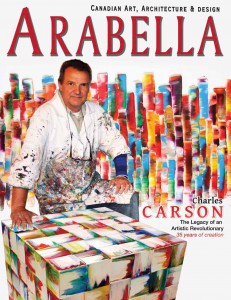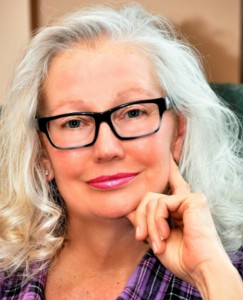« L’héritage d’un artiste révolutionnaire – 35 ans de créativité »
|
ARABELLA magazine, Canada, USA, édition, 2013 Un Jewel Brilliant » Debra Usher «L’artiste canadien Charles Carson est reconnu sur la scène artistique internationale comme le père du « Carsonisme »- un terme désignant ses créations singulières et profonde, pleine de couleur et de vivacité. Il a passé les 35 dernières années à peindre des toiles à couper le souffle, des images qui donnent à réfléchir, alimentée par une passion pour les régions tropicales de l’Amérique latine, lâ où il vécu près de 10 ans et a beaucoup voyagé. Son langage pictural unique rend son œuvre très prisé à collectionner. Son nouveau défi pour les trois prochaines années – la création de murales et de pièces majeure de musée pour les marchés de l’Europe et du Moyen Orient. » « Presque dès le début, il était entendu que Charles Carson serait un succès …. » « …Ses coups de pinceau sur la toile s’apparentent à la flambée des notes trouvées dans les meilleurs solos de saxophone alto. Peut-on oser dire David Sanborn et John Coltrane sont dans le même souffle que Charles Carson? L’histoire décidera, mais en son temps Carson donne une pointe vibrante pour le mystère incomparable et unique de la vie – qui se reflète dans ses oeuvres. » «… Charles Carson a adopté son propre mode d’expression avec la passion d’un maître, mais il possède aussi le nerf d’un aventurier et l’intelligence d’un historien …» «…Aujourd’hui, Carson a acquis une reconnaissance au niveau international et reconnus par de nombreux historiens et experts en arts pour son style unique « Carsonisme ». «…Il est tout simplement impossible d’ignorer un artiste qui a découvert de nouvelles valeurs de l’art, manière qui remet en cause toutes les tendances, des genres ou styles qui dominent le marché de l’art traditionnelle contemporain d’aujourd’hui. Charles Carson à la capacité d’imaginer, interpréter et transposer sa vision unique du monde autour de lui avec force et subtilité. « Il est considéré par la critique comme l’un des plus grands artistes contemporains de ce siècle, Maître Carson ayant saisie le langage picturale parlé autrefois par Mondrian, Riopelle, Jackson Pollock, Sam Francis et Wassily Kandinsky, l’artiste a su prendre les devants – Car la création et la mise à jour de son mouvement tout à fait unique et original, interprété d’une tel façon théâtral et magistral, qu’aucun de ces grands maître ou génies de l’art des temps passé, n’avais su imaginé ou même pensé jusqu’à présent. » « Ces figures légendaires ont accompli des exploits extraordinaires, mais aucun n’a créé d’une manière si unique, si personnel son style, qu’il ne pouvait-être définie par un isme. Carson, par son unicité inégalé, un nouveau mouvement est né. Le « Carsonisme ». Source : ARABELLA magazine, Canada, USA, édition, 2013
Magazine ARABELLA, Winter, 2012/2013 The Legacy of an Artistic Revolutionary Charles CARSON, mba Artist to Collect / 35 Years of Creation A Brilliant Jewel written by Debra Usher The term “Carsonism” reflects Carson’s All consuming devotion to original painting. He is the innovator of a unique pictorial language or style, of which he is the father and founder. His mosaic technique has a complexity of colour and vibrancy, yet does not leave us clues to his secret. He knows where he is going and, as his audience and art lovers, we simply have to follow. His brushstrokes on the canvas are akin to the soaring notes found in the best alto sax solos. May one dare say David Sanborn and John Coltrane in the same breath as Charles Carson? History will decide that, but in his own time Carson gives a vibrant tip of the hat to the incomparable mystery and uniqueness of life – all of which are reflected in his canvases. From almost the beginning it was understood that Charles Carson would be a success. The perfect coordination of skill, movement, pace and organization and the incredible brightness of his palette remind us of the wonderful paintings from 1950-1960 of Jean-Paul Riopelle. But Carson, by his clarity and transparency, shows us he is different and of equal quality. It is an abundance of colour and density that sets him apart. In Carson’s work he presents us with a stunning depth to his palette, as he slips from abstraction to figurative within a single brush stroke. He takes us on a trip through a universe of varying dimensions; to discover a world in which living forms are born of his own dreams and reflections – on Earth, over the sea or via the flight of a bird. Charles Carson has embraced his chosen mode of expression with the passion of a master, but he also possesses the nerve of an adventurer and the intellect of a historian. He has devoted himself entirely to his art since 1983, participating in numerous exhibitions in Canada, the United States, Europe, Asia and South America. Today, Carson has gained recognition at the international level and become known among art historians and consultants for his unique style. He is considered by critics to be one of the great contemporary artists, having learned the pictorial language once spoken by Jean-Paul Riopelle, Jackson Pollock, Sam Francis and Wassily Kandinsky, and he has forged forward – translating and updating this style in wholly original ways these earlier geniuses never even imagined. A “Natural” Talent Born in Montreal in 1957, Carson discovered his calling as he approached his teens. At this time, his artistic heroes included Renaissance greats Leonardo da Vinci and Michelangelo, as well as the modern masters Turner and Matisse, all of whom Carson says “devoted their lives to the pursuit of excellence and whose art continues to move people generations after their passing. Their genius is a constant source of inspiration.” Yet, young Carson found himself frustrated with his own futile attempts at originality. “My imagination was both my greatest asset and my worst enemy,” he admits. “I had the sense of a higher place beyond – a unique destiny, other universes to discover. In my mind, I dreamt of a creative life that was not subject to anyone’s authority. Refusing to follow a predetermined path…I was determined not to offer my work for sale until I had achieved my goal of creating a new pictorial language without any direct resemblance to an existing style or technique.” So, Carson embarked on a quest to find his vision – to Europe, Asia, the US and South America, living in a dream world fueled by the sea, forests, wildlife and his lofty personal ideals. “I wanted to live new experiences, artistically as well as culturally,” he recalls. These many journeys gave rise to years of disciplined research to develop the pictorial language with which Carson is now identified. “I continued to perfect my technique for juxtaposing colours, using acrylics to create vivid abstract forms,” he explains. “I spared no experimentation with special effects. I would drop bags of paint from the roof of the house and rush to see the splatters they created on the sidewalk! Or, I would use a drill to spin a panel I had coated with different colours of acrylic paint. Not to mention the balloons filled with paint that I would burst over canvases! I even used an old bicycle wheel to spread colours on a canvas to see the effect it produced.” After residing in South America for 10 years, he also stumbled upon the true inspiration for his groundbreaking art: the environment. Carson is strong, but somewhere in Colombia he found that even the strongest river cannot flow uphill. He became infatuated with the world’s fragile beauty and grew indignant in the face of man’s lack of conscience. It did not take him long to find out the world was upside down and when he discovered this, he sought to make it right. In Carson’s view, art should capture the beauty of the environment and simultaneously instill a desire in others to preserve that beauty. “I am very sensitive to ecological and environmental issues, so nature is the source of my inspiration and I strive to represent it in different forms transformed by the mind’s eye. My paintings are vehicles for communication, communion; living works.” His art, being widely collected, attests to its appeal. His auction records at esteemed houses affirm this. In Search of a Personal Style Finding his passion for painting in 1970, Charles Carson began to work within traditional motifs, gaining inspiration from his surroundings. These first paintings were figurative. However, in the end, he found they were inhibited and unsatisfactory for embodying his artistic needs. On the journey to develop a more individually suited approach, abstract and figurative gestures were combined. This technique, along with his unique depiction of pictorial image as written universal glyph, distanced Carson from other stylistically-familiar motifs. At thirty-three, he travelled to Latin America where the spirit of inspiration gleaned from the South American landscape led him to a new personal era of expression. He made a name for himself in Colombia, where he held numerous exhibitions and developed an amicable relationship with the great Colombian painter, Fernando Botero. While many native artists left for Europe and America in search of fame and fortune, Carson found international recognition emanated from his stay in South America. The influence that painters, topography and people of Colombia exerted upon the young artist, and the vibrant and ancient culture he absorbed, informs much of his work today. It would seem that Kandinsky’s words from his immortal little book, The Spiritual in Art, published in 1910 (“The boldness of colour in a painting must attract the spectator forcefully, and at the same time mask the deeper content.”) left a lasting impression on the young artist. The impact of Carson’s colours grew in the tropical vistas, far away from the winter of his youth – those frigid nights where shapes haunted his compositions, giving them a certain dimensional presence. In those cold days, he learned to focus on the hidden dynamic that so energizes his work. He paints movement with a technique and energy appropriated from masterful predecessors like Mondrian, Jackson Pollock or van Gogh. Those legendary figures accomplished extraordinary feats, but none worked in a manner so unique that his style could only be identified by his name. Carson, on the other hand, has “Carsonism.” (…)
PUBLICATION: http://issuu.com/carsonisme/docs/magazine_arabella_inglewood_fine_art_-_charles_car . . . . Attention aux imitations, Stéphanie Rivet – Éric Dupont – Patrick Pépin – Galerie d’art Beauchamp – Le Luxart – Bel Art Gallery – Galerry Rufus – Galerie d’art Emeraude – Beauchamp Art Gallery – Galerie Courtemanche – Latitude Art Gallery – Whistler Village Art Stephanie Rivet – Eric Dupont – Gallery – Les Galeries d’art Beauchamp – Hazelton Fine Art Galleries – Galerie d’art Ambiance – Chantal Malet – Galerie d’art Céleste. |


